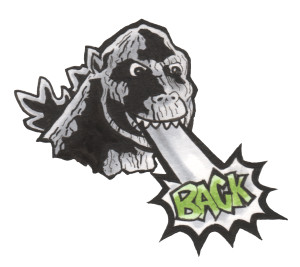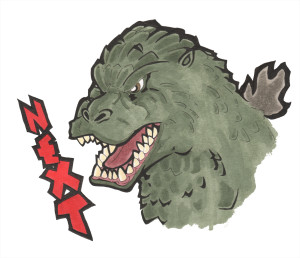Gamera Vs Barugon – 1966, Shigeo Tanaka, Japan
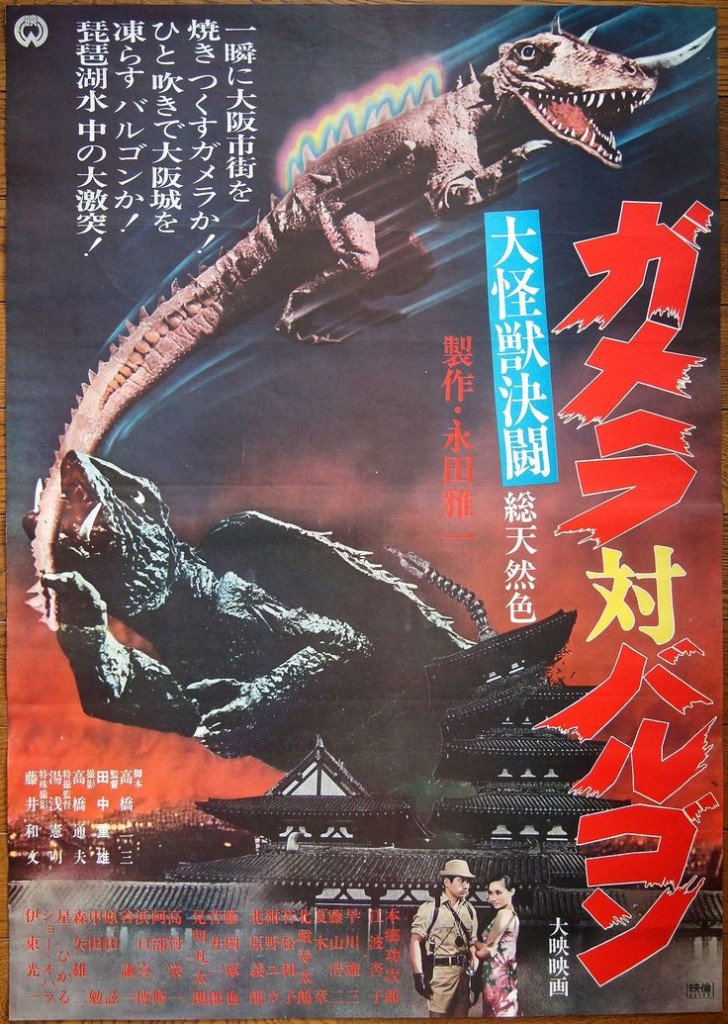
I love this big, lumpy, turtle shaped idiot.
Gamera’s big debut was a little rough. It was enjoyable, yes, but in today’s world, Gamera The Giant Monster just isn’t a movie that anyone needs to see unless they’re already way into kaiju cinema. It fell a little flat, and for the most part, looked more at home amongst American B-movies of the 1960’s than alongside the higher quality Japanese monster movies it wanted to imitate. All that shit is over now, though, because Gamera Vs Barugon is the huge, lumbering bumble forward in quality we want it to be. This freakin’ movie is absolutely worthy competition for Toho, and in fact, it leaves some of their lesser “name brand” Kaiju in the dust. (Suck it, Varan!)
THE PLOT- After an adventure to smuggle a priceless Opal out of the jungles of New Guinea backfires, Barugon, who is in no way a rip off of Toho monsters Anguirus or Baragon (he totally is) is unleashed on Japan, and he’s eager to hit them with a blast of irrational, crazed lizard fury the likes of which they’ve not known for several weeks. And he might have gotten away with it, too, if it weren’t for that meddling Gamera, who is back on Earth after our efforts to kill/launch him into space proved to be a failure. The two big bad beasties slug it out, in keeping with tradition, and in the end, it’s giant reptile VS giant reptile in a heated, knock down, drag out lizard war for the ages. Why don’t people just move away from Japan at this point? No excuse is a good enough reason to stay put with this crap going on.
The first thing you need to know about Gamera Vs Barugon is that Gamera is barely even in it. Actually, that’s the movie’s greatest flaw, no where near enough screen time for the headlining act; our gluttonous tortoise beast shows up, is prompty frozen solid by Barugon’s icey gas spray (quit laughing), and then he’s out of the picture for 90% of the runtime. It’s just Japan versus Barugon until the eleventh hour, when a freshly thawed Gamera whirls into frame to beat Barugon’s ass, and then the credits roll. This is not an ideal situation given that this is Gamera’s sophomore outing, but since the burden of carrying this picture is all on Barugon, we should probably talk about him a little bit.
Firstly, I want to address the elephant in the room; This dopey ass lizard creature is undeniably a straight up rip off. The whole “BARAGON/BARUGON” thing is, for sure, pretty dammed hard to dispute.
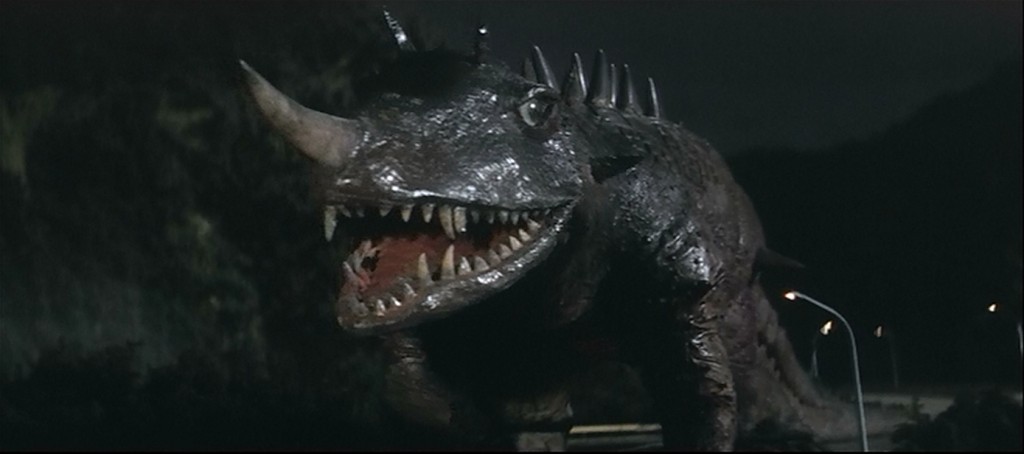
This is BarUgon (Daiei).
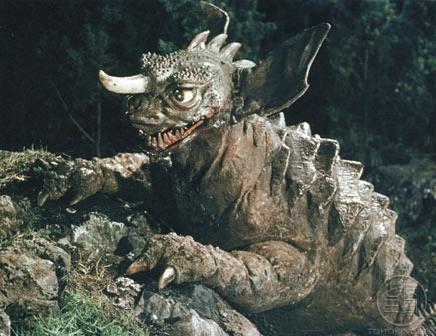
And this is BarAgon (Toho).
BarAgon, who, as you can see, looks quite a lot like our boy BarUgon, made his debut appearance in Toho’s Frankenstein Conquers the World one year prior to the release of this film, so trying to argue that there wasn’t any sort of plagiarism here would be a lot like when Vanilla Ice tried to say he didn’t rip off Under Pressure. That argument would just be embarrassing, and Daiei would be better off just admitting to the theft and taking their lumps. The weird thing is, however, that aside from the name, Barugon actually has more in common with Anguirus, than he does with Baragon. Check out the facts; Anguirus is, yet again, another four legged, gigantic lizard monster who had a horn on his Schnozz and spikes on his back. In addition, Anguirus and Barugon both first appear in the second installment of their respective franchises (Barugon here in Gamera Vs Barugon and Anguirus in Godzilla Raids Again, Toho’s second Godzilla film), and both films feature dramatic monster battles that take place in Osaka, Japan, right outside the famous Osaka Castle. I even think Barugon looks a bit more like Anguirus, right down to a mutual lack of floppy ears. Have a look:
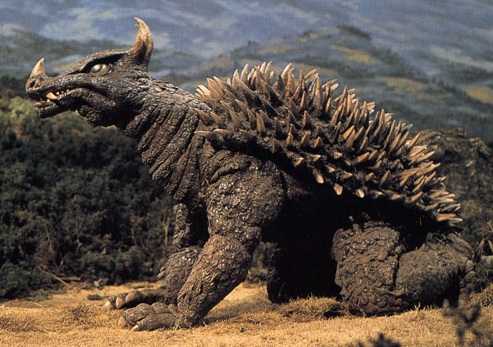
They could be brothers.
In summation, yeah, Barugon is a damn rip off.
All that being said, I hated this freakin’ guy before I even started watching this movie. How could I not, given that he was little more than a shameful xerox of Baragon, who had long since warmed my heart with his floppy ears and hilarious antics. I knew from photographs I had seen that Barugon didn’t even have ears, so he was indeed on my shit list right out of the gate; but imagine my surprise when he won me over more or less immediately! Barugon is actually a really well done monster, the suit looks like garbage, of course, but Daiei managed to squeeze more personality into him than Toho did with either of Anguirus or Baragon in their respective debut films. This big, scaly dofus does some really great stuff that I’ve never seen a giant monster do before; firstly, he’s the only Kaiju I’ve ever seen sit down in the middle of a decimated city and take a nap. Barugon totally does that. After smashing up Osaka, he thinks “That was good. This place is mine now. Think I’ll take a snooze.” Awesome. Then, when Gamera shows up, our boy Barry hunkers down behinds some trees with just his eyes poking up, as if to get a feel for the situation before figuring out how he wants to react to the appearance of this potential foe. The decision he reaches is that it’s time to throw down, and so after a brief confrontation, Barugon blasts Gamera with his ice spray and freezes him solid, at which point he prods Gamera’s big, frozen head with his horn, as if to make sure his opponent is really down for the count. These are all small things, but they make an amazing difference in selling this ludicrous looking puppet as a living creature, and I came out of this fairly impressed by the attention Daiei put into the subtleties of Barugon’s personality. That, more than anything else, excuses his plagiarized monster lineage, and so B-Boy get’s a pass from me, ultimately.
There are also other ways in which Gamera Vs Barugon succeeds where many films in this sub-genre continue to fail. The best thing the movie does is that it gives us interesting human characters and a story which would still be fun, even if it didn’t have a single giant monster in it. That’s huge. The bungled Opal smuggling sequence is great, it’s fun and exciting, and combines elements of gangster cinema and jungle adventure films, which is an odd mix, but which pays off in spades. Our two most important humans in the picture are, Onodera, who is a ridiculously over the top douche bag and also our villain, and Keisuke, who is our protagonist. This whole “Retrieve a giant opal” thing is clearly a shady, under the table type of operation, and actually I’m not sure why that is. It seems like you should be legally allowed to be a treasure hunter and bring a rad ass opal back from the jungle if you want to, but we get the message that this was evidently a very illegal thing that they are doing, and that actually works to the films advantage in a very clear and tangible way. Keisuke inherits a sort of ambiguous morality through his association with these shady dealings, and that makes him a more interesting character than we’re used to seeing in this films. It also gives us Onodera, who again, he’s a fucker. Let’s talk about him.
Onodera has a rap sheet longer than Barugon’s retractable lizard tongue. It’s freaking crazy how much of a dick head this guy is. Firstly, he allows one of his gem heist conspirators to suffer a fatal scorpion sting, so as to ensure that Onodera receives a bigger cut of the take. Then, when his Keisuke fails to die from natural Jungle related risks, Onodera grenades the cave shut in an attempt to rub him out, too. The final conspirator is Keisuke’s disabled brother, who hid the opal in that scorpion infested cave during the war in the first place. Onodera pays a visit to this disabled war veteran and kicks the hell out of him and his wife, before leaving them both trapped in a house directly in the path of Barugon’s incoming stomp fest. They both die. The real coup de gras comes later, though, at the end of Act II. At that point, every single attempt to lay the smack down upon Barugon had been an abject failure, and things look grim. A new plan is formulated, which, at this point, looks to be literally the only chance mankind has at defeating Barugon and saving Japan. This last ditch plan involves the use of a giant, fantastically valuable diamond, which must be loaded into a cool light projector thing, and used to lure Barugon into the water, which he is allergic to, if I didn’t mention that before. “Diamond, you say?!” Says Onodera, who immediately jumps into action, zooms up alongside the vessel carrying a small number of brave men literally in the process of attempting to save the world, only to open fire on them and steal this diamond, which, one final time I want to stress this; is, as far as anyone knows, the only thing that can save the entire human race. Where does he think he’s going to spend the money when the entire planet is destroyed?! Also I want to remind you that Barugon only exists because Onodera is a douche bag in the first place. It takes an extreme, flamboyant kind of shit head to rob people who are actively working to save the world from a cataclysm that was your own doing to begin with, but Onodera is that flamboyant shit head, and they really don’t get any shittier. It’s impressive.
If we’re talking about what’s wrong with Gamera Vs Barugon, again I would call out it’s shocking lack of Gamera to be it’s most damaging fault. For most of the picture, he’s frozen, face down, in Osaka. If he’s not frozen, he’s either on screen fighting Barugon (this happens twice, the first time leading up to his freezing, and the second time resulting in Barugon’s demise,) or he’s off attacking Hydroelectric dams and other such installations so that he can gobble up all the delicious energy they produce in order to satiate his gluttonous Turtle hunger, and that’s almost all off camera. Anyway you slice it, Gam-Gams needs more screen time, and Daei should have known that.
But that is the worst thing about this movie. It certainly looks lower budget than Toho’s pictures, but that’s pretty much not a problem. As I’ve said in my review of Gamera’s first movie, his frumpy inadequacies are more endearing than anything else, since the very act of watching a Gamera movie is tantamount to rooting for the underdog anyhow. In no small way I would say that Gamera Vs Barugon is a classic of 1960’s Kaiju that doesn’t need to feel all that inferior to what Godzilla was up to at that time.
B+


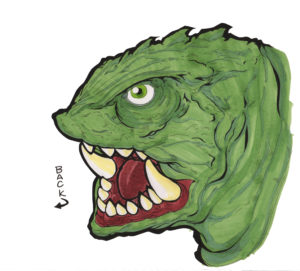
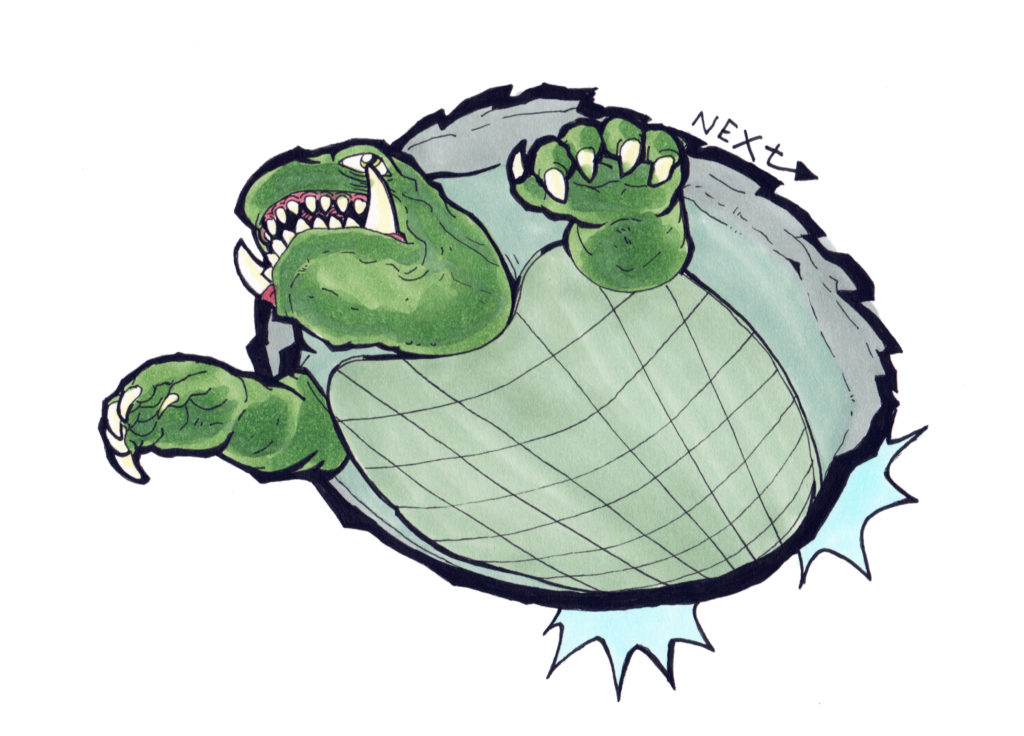
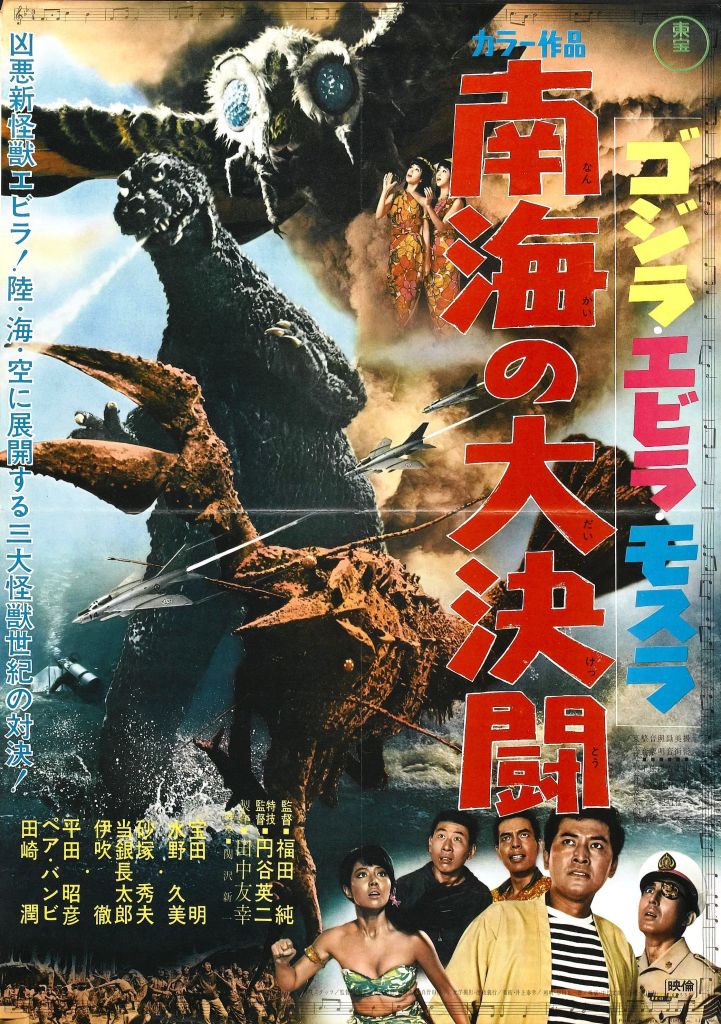
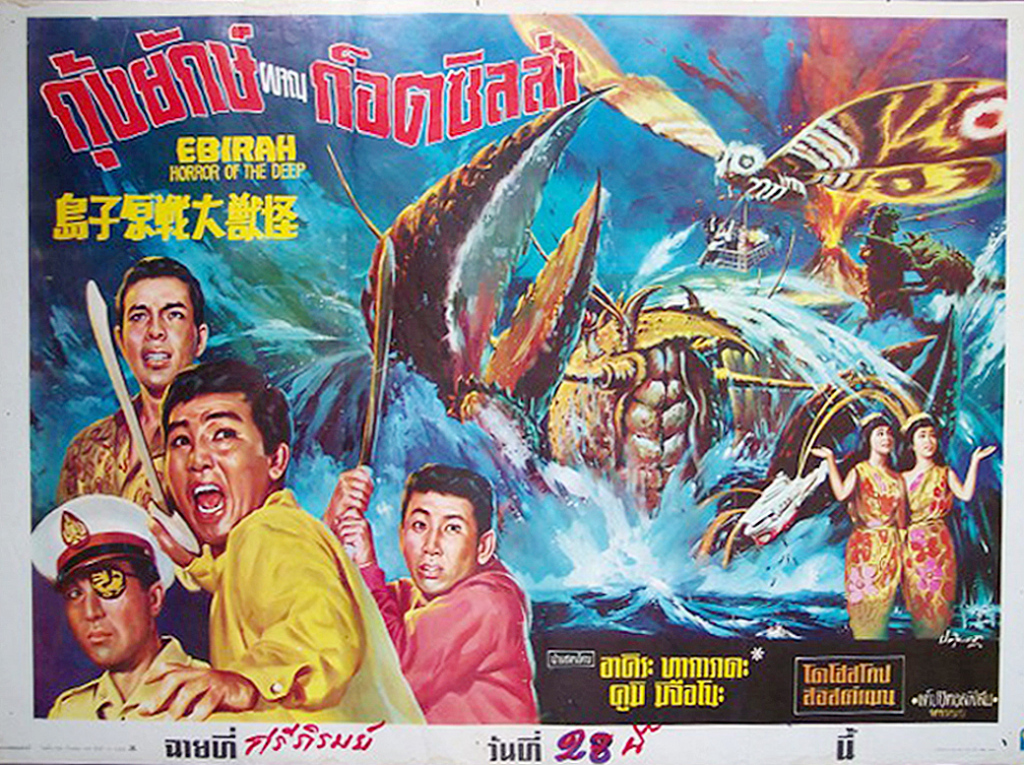
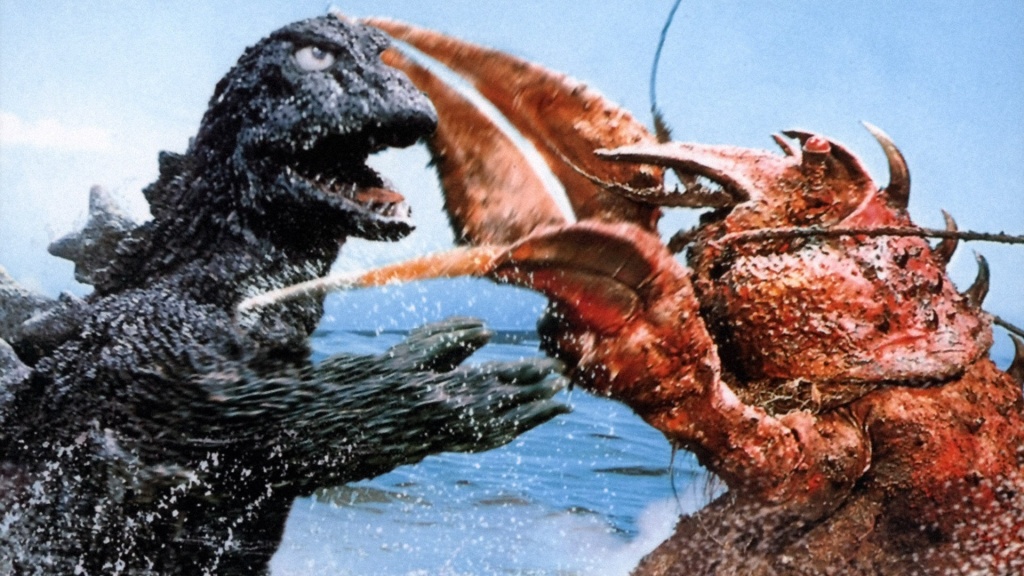 I imagine that Ebirah would be Godzilla’s most delicious foe.
I imagine that Ebirah would be Godzilla’s most delicious foe.
